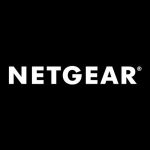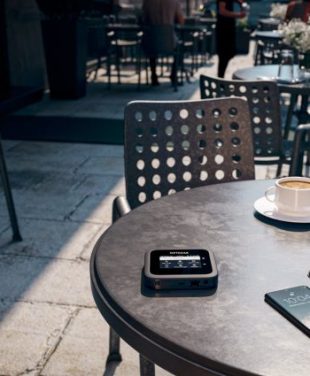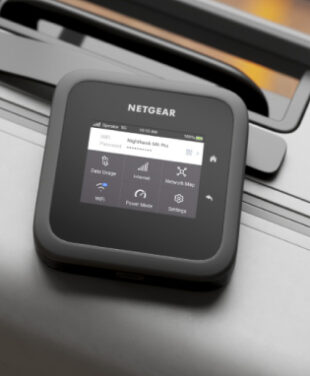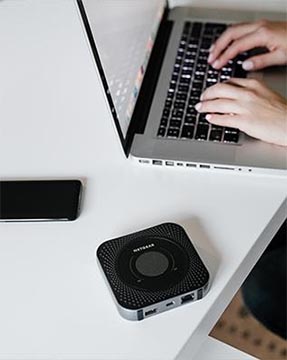Are you worried about public WiFi security? Here, we uncover the threats to mobile hotspots and how NETGEAR Nighthawk M6 and M6 Pro can keep your important information safe while you are online.
IN THIS ARTICLE
Public WiFi: Unmasking the Hidden Online Dangers
Many public places have WiFi hotspots. Without free WiFi, customers won’t stick around, and that can negatively affect business. Cybercriminals create cybersecurity risks that could compromise your private information when using public WiFi. Fortunately, the best mobile hotspots are up to the task, incorporating the latest impenetrable security features to keep spam, malware, and malicious intruders out.
Why Public WiFi is a Security Concern
Public WiFi networks are convenient, although not as safe as encrypted home WiFi networks. Bad actors constantly seek opportunities to infiltrate unsecured WiFi networks and cause harm. Wireless network security is essential for peace of mind and a satisfying online experience. Guest network devices are targets for hackers looking to exploit personal information, so let’s explore some WiFi security vulnerabilities, plus methods to keep the bad guys away.
Unencrypted Networks
Mobile hotspot security is often turned off by default. Public WiFi networks are sometimes open and unencrypted, creating security risks. Hackers can exploit this vulnerability and access information on such networks effortlessly. Encryption turns WiFi signals into code that is very difficult to crack. The best hotspots include WPA3 advanced encryption standards which can be conveniently enabled in the mobile router settings.
Man-in-the-Middle Attacks
Man-in-the-middle (MITM) attacks are common with free WiFi hotspots and open networks. Hackers can access information as data travels from your wireless device to a website via the network’s router. MITM attacks range from simple snooping to theft of credit card information, banking details, and personal files.
Malicious Websites
Malicious websites are websites that masquerade as the real thing. They are created by cybercriminals who can then steal data and embed malware. Phishing emails are often used to lure visitors to malicious websites. Nighthawk M6 and M6 Pro mobile hotspot routers with wireless security tools such as firewalls and WPA encryption with temporal key integrity protocol can stop hackers from gaining access.
How to Identify a Malicious Website
Some fake sites are difficult to spot, while others have telltale signs that something may be amiss, such as:
- Asking you to download software, save a file, or run a program.
- Alerting you that your device is infected with malware, or the software needs updating.
- Claim that you have won a prize, then request your personal information.
- Use HTTP as the web address prefix instead of the secure protocol HTTPS.
- Have errors, misspellings, and design inaccuracies.
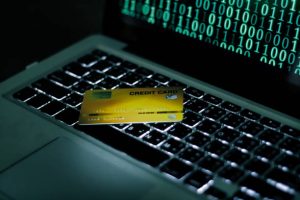
Dangerous Threats in 2024
The sophistication of Cybercriminals is evolving to keep pace with improving mobile WiFi technology. Here are a few of the most dangerous threats in 2024.
Malicious hotspots
Cybercriminals set up bogus public WiFi hotspots to break into WiFi networks, laptops, Android devices, and more. Also called evil twin attacks, malicious hotspots appear like legitimate sources of free WiFi. Malicious hotspots often have unassuming names like free WiFi or Guest WiFi. These fake hotspots usually have no encryption key, security measures, or passphrase required to connect. Once online, your information flows directly to the cybercriminal.
Evolved Malware
Hackers can install malware straight onto a public WiFi hotspot that doesn’t have wireless security protocols. The malware then spreads to the connected devices. Malware can also spread through fake ads or pop-ups, which install the malware once clicked. Malware can be elaborate and convincing, allowing hackers to gain access to sensitive information.
Identity Theft on Autopilot
Windows Autopilot has been around since 2017. Autopilot offers a streamlined provisioning process for delivering computer hardware and software to end-users. There are concerns around Autopilot methods used to side-step security measures on WiFi router access points. Individuals and organisations can be vulnerable to rogue onboarding of devices unless adequate security measures are in place.
Public Network Sniffing
Hackers can get your data even without directly accessing your device. They can use special software to infiltrate unsecured public WiFi networks. Sniffing (snooping) is when hackers look for anything that can benefit them. Public network sniffing includes stealing data in transit, finding your pre-shared key, looking at your browsing history, and other ways of accessing your private information.
How to stay safe on public WiFi
While there is no 100% guaranteed online protection, there are ways to make public WiFi connections much safer. These include:
Wired Equivalent Privacy (WEP): A security protocol first specified in the WiFi 802.11b standard by the WiFi Alliance. WEP provides a wireless local area network (WLAN) with a level of security comparable to what is usually expected of a wired LAN.
Message Integrity Check (MIC): A security improvement for WEP encryption. A MIC digital hash can verify that there has been no alteration to a message.
WPA3 Encrypted Security: The WPA3 security standard is more robust than the earlier WPA2-PSK security type, making public WiFi connections safer.
Unfortunately, many public WiFi hotspots don’t provide the above levels of protection. Here are 10 ways to stay safe while you are online.
1. Avoid accessing sensitive information
Avoid doing any banking on public WiFi. You should also avoid logging into health service portals or your government-related profiles.
2. Use a VPN
A VPN (Virtual Private Network) is an important safety tool that should be used when you are online. VPNs encrypt data with impenetrable algorithms before the data leaves your device, keeping it safe from hackers. A public WiFi connection is a lot more secure with a VPN.
3. Clear your cache and browsing history
Malicious intruders may snoop on your browsing history and cache to look for sensitive information. Clear your cache and browsing history before connecting with an unsecured network.
4. Turn off auto-connect
People often leave the auto-connect feature active on their mobile devices. Although convenient, this can create an online security weak point. Turn off auto-connect when you are not using your WiFi devices.
5. Log out of your accounts
Log out of accounts or websites you use on public WiFi networks. This will stop bad actors from accessing your search history and personal information.
6. Use two-factor authentication
Two-factor authentication (2FA) adds an extra layer of device security. It will make it much harder for hackers to infiltrate your accounts.
7. Use a mix of passwords
Use several different network passwords for your online accounts. This will make it harder for hackers to access your sensitive information.
8. Update your software
Software security developers release updates to fix bugs in their systems. Ensure your operating system and apps use the latest secure WiFi software fixes.
9. Use antivirus software
Antivirus software is important on unsecured networks. This software can help you stay safe online and avoid exposing your important information to hackers.
10. Disable file sharing
When file sharing is turned on, anyone connected to the same public WiFi network can access your files. Turn file sharing off to avoid sharing your files with cybercriminals.
How Does a VPN Work?
A VPN service encrypts data and reroutes it through a VPN server chosen by the internet service provider (ISP). This hides your IP address, internet connection, and information from malicious intruders. A VPN masks your online activity and location. It also bypasses geo-restrictions so you can access content safely from anywhere.
Nighthawk M6 & M6 Pro Mobile Hotspots
Now the great news! NETGEAR Nighthawk M6 and M6 Pro mobile WiFi hotspots offer secure and private connectivity for people on the go, wherever your travels take you. These state-of-the-art NETGEAR hotspots allow you to set up a private WPA3 security encrypted network with a VPN powered by Bitdefender. Additional features such as Smart Parental Controls ensure every device in your private network is protected, and every user is safe from exposure to cybercrime.
Nighthawk Mobile Hotspots for Peace of Mind
Mobile hotspots connect to the nearest mobile network tower. Nighthawk M6 and M6 Pro hotspots are proactive in protecting any data transmitted through the connection. The best mobile hotspots act in much the same way as public WiFi hotspots and phone tethering, but with the addition of state-of-the-art security so you can connect to the internet wherever, whenever, stress-free.
Your Personal Encrypted Network
With a NETGEAR Nighthawk Mobile Hotspot, strong encryption is included. This security mechanism renders transmitted data indecipherable to unauthorised entities. You can also disable SSID broadcasting to hide your hotspot network, making it less susceptible to detection. Nighthawk hotspots allow you to implement Media Access Control (MAC) address filtering to specify which devices are permitted on your network.
NETGEAR mobile hotspots automatically update the firmware to ensure security systems are up to date. You can monitor the status of all your connected devices in real-time and detect unwanted intrusions. However, even with all this technology, it’s best to exercise caution when connecting a mobile hotspot to a public WiFi network. Avoid connecting to unsecured public hotspots that don’t have authentication and encryption measures in place.
Nighthawk M6 Pro Features
The Nighthawk M6 Pro uses the latest 5G mmWave technology to deliver blazing-fast mobile WiFi speeds up to 8Gbps. It uses the 6GHz band and has a 2.5 Gig Ethernet port for dedicated wired connections. Nighthawk M6 Pro includes:
- Unlocked ability to connect in 125+ countries worldwide.
- WiFi coverage of up to 2,500 square feet.
- Ability to connect up to 32 devices simultaneously.
- 13 hours of battery life for all-day use.
- Change settings, share access, and monitor data usage using the 2.8” LCD touchscreen.
- Powered by the Qualcomm Snapdragon X65 5G Modem-RF System.
Nighthawk: The Future of Mobile Networking
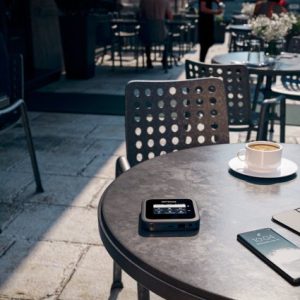 Fast and reliable mobile WiFi without security flaws is now a reality. With Nighthawk M6 and M6 Pro, you can instantly connect for streaming, gaming, or conferencing from anywhere. You can select the carrier of your choice or switch carriers with a simple SIM card swap. Choose a prepaid plan, unlimited data plan, or another service plan. Connect with family, friends, and colleagues when travelling locally, nationally, or internationally. It doesn’t get any better than that!
Fast and reliable mobile WiFi without security flaws is now a reality. With Nighthawk M6 and M6 Pro, you can instantly connect for streaming, gaming, or conferencing from anywhere. You can select the carrier of your choice or switch carriers with a simple SIM card swap. Choose a prepaid plan, unlimited data plan, or another service plan. Connect with family, friends, and colleagues when travelling locally, nationally, or internationally. It doesn’t get any better than that!
Nighthawk M6 and M6 Pro safely ensure WiFi-protected access without unwanted security issues. They are small enough to fit in a pocket or purse, yet powerful enough to deliver high-speed encrypted connections wherever you are. The future of mobile networking is here with NETGEAR Nighthawk.

